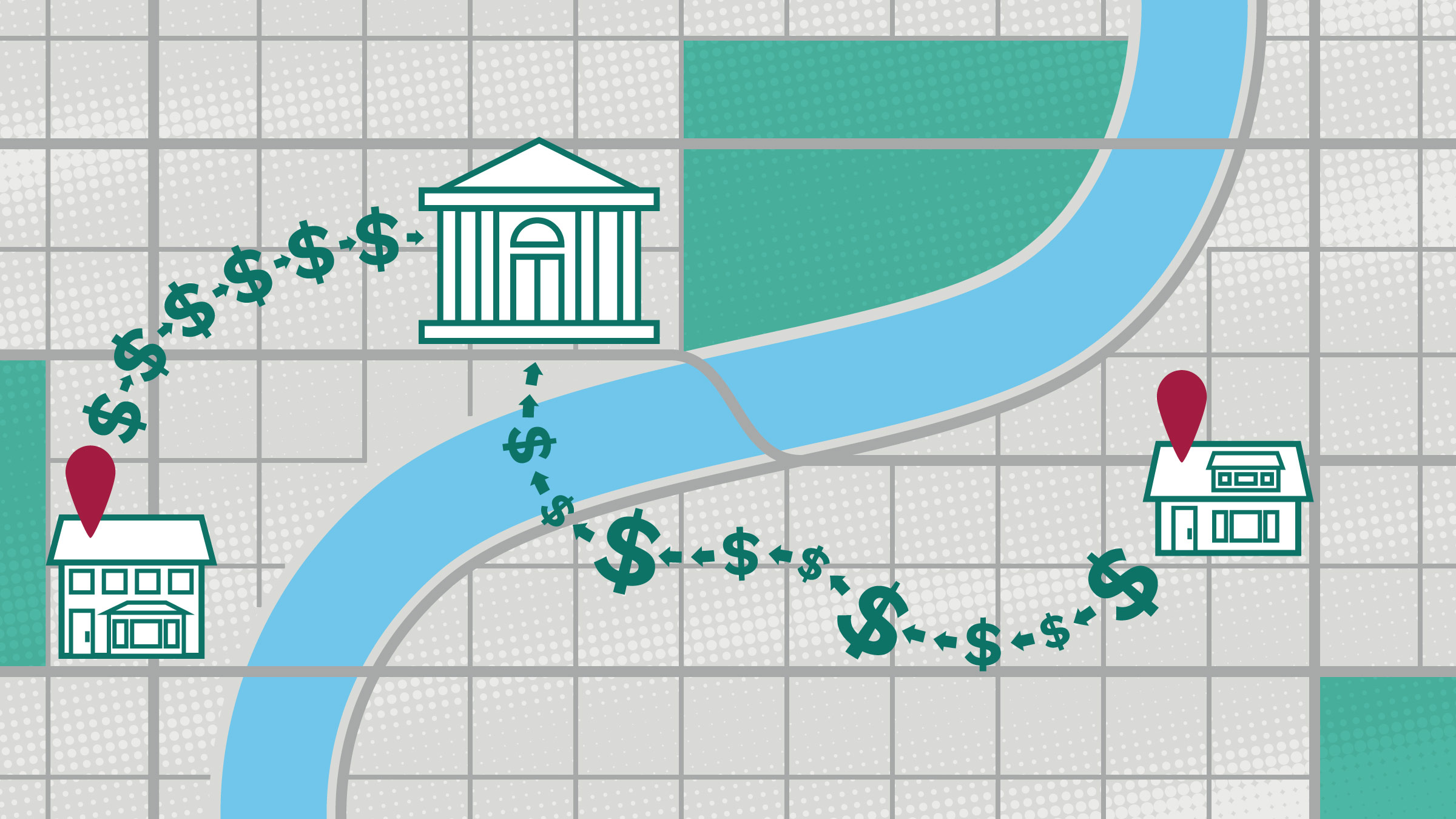This essay is based on a paper titled "Credit Availability in the Minneapolis-St. Paul Hmong Community" by Maude Toussaint-Comeau and Robin Newberger of the Federal Reserve Bank of Chicago, and Jason Schmidt, Arthur J. Rolnick and Ron Feldman of the Federal Reserve Bank of Minneapolis. In addition to these colleagues, the authors thank Dick Todd of the Federal Reserve Bank of Minneapolis for valuable comments.
Meaningful program review can be achieved only through measurement and critical analysis. Systematic research of community economic development programs has been limited. Accordingly, your challenge is to vastly expand the information base.*
Alan Greenspan
Chairman, Board of Governors
Federal Reserve System
When Congress passed the Community Reinvestment Act in 1977, it had a specific outcome in mind: to encourage depository institutions to help meet the credit needs of the local communities in which they operate, including low- and moderate-income neighborhoods. As one of the federal regulators authorized to implement the law, the Federal Reserve has a supervisory process in place to measure whether banks are meeting such credit needs. However, there is a broader goal implicit in the CRA and explicit in Chairman Greenspan's charge, and that is to broaden our understanding of how credit markets operate. Why? Because the well-being of communities can suffer when households and firms cannot effectively access funding; when credit markets do not work well, standards of living can fall.
Clearly then, the issues surrounding credit markets are many, and they include questions about credit availability within certain subsets of a city or a neighborhood. For example, have lending groups formed within certain low- and moderate-income communities? Do these groups form within certain minority groups? How do they operate? Have these groups formed because their constituents have been discouraged from seeking loans at banks? Are there gaps—real or perceived—between banks and those ethnic communities? These are important questions, and they are difficult to answer in broad terms. Reviewing results from CRA exams offers some insights, but such data are naturally limited. To gain a clearer understanding of the ability of households and firms to access credit requires that we ascertain another source of data focusing on how they fund themselves. (See more on the CRA.) Thus, these issues are best examined at a micro level, within local communities, and through a research program designed to get at the answers.
One such research program began in the mid-1990s when the Federal Reserve Bank of Chicago and the University of Chicago joined together to survey the credit markets of two Chicago neighborhoods, one black and the other Hispanic. Among other findings, these surveys revealed the importance of informal credit for businesses (for example, from family members, suppliers and so on) and showed that the degree and type of informal lending varied between the two neighborhoods. To advance this research, the Federal Reserve Bank of Minneapolis joined with the Chicago Fed to survey the credit experience of a growing minority group in Minneapolis-St. Paul—the Hmong, who are refugees from Southeast Asia.
The survey of Minneapolis-St. Paul's Hmong business community addressed the question of how a refugee group with cultural and economic disadvantages would cope in a localized credit market. The Hmong, who until the 1950s had no written language, arrived in the United States with little or no understanding of English, let alone of Western business and financial markets. How would these people fare in a society—and more specifically, in an economy—that thrives on forms, business plans, acronyms, laws and regulations? Would Hmong entrepreneurs have access to credit from banks?
In the end, the answer is that the Hmong entrepreneurs have done surprisingly well, at least those who have opted to form businesses in Minneapolis-St. Paul, according to a survey of Hmong businesses and a control group of business owners in the same neighborhoods. The Hmong business owners are fairly new. However, it appears that Hmong business owners use bank financing as much as their neighbors did at startup. Also, it appears that an engaged banking community willing to reach out and communicate with the Hmong, along with a supportive community environment, is important to Hmong entrepreneurial success.
In particular, this essay will address four questions:
- How available is startup financing for Hmong small businesses in Minneapolis-St. Paul?
- What sources of credit are actually used?
- Do Hmong entrepreneurs report substantial barriers in their attempts to obtain credit?
- Are there unique characteristics about the Hmong community or the local banking environment that have affected the access to credit of small business owners?
Our answers are not definitive, inasmuch as there are limitations—discussed later—to this specific survey and the answers it provides. Such caveats, though, are endemic to this type of research and only bolster the call for more investigation. More generally, any survey is a snapshot of a particular community at a particular time; as such, it cannot possibly provide a clear picture from every possible angle. However, that does not prevent us from drawing important conclusions. Taken together with the earlier work in Chicago, and with the addition of more research in the future, this snapshot will expand into a more complete picture of how credit markets work.
Before addressing the above questions in greater detail, we will first provide a description of the Hmong in Minneapolis-St. Paul and of how the survey was conducted. At the conclusion of this essay, we will consider avenues of further research and analysis.
The Hmong experience
The Hmong are immigrants from Laos and other Southeast Asian countries who settled in the United States as political refugees after the Vietnam War. The 2000 decennial census data put the total Hmong population in the United States at roughly 169,000, making it one of the fastest growing Asian groups in the nation. Minnesota and Wisconsin have the largest concentrations of Hmong-Americans in the United States as a result of both direct settlement from Southeast Asia and resettlement. The latest enumeration shows 41,800 Hmong in Minnesota, roughly one-fourth of the nation's total and almost 2.5 times the 1990 total of 16,833. St. Paul, with a Hmong population of 24,389, remains the home of more than half of all Hmong in Minnesota. Minneapolis has the next largest population, with 9,595 Hmong residents, followed by two northern suburbs of Minneapolis, Brooklyn Center with 1,346 and Brooklyn Park with 1,226. Indeed, the Minneapolis-St. Paul area boasts the largest Hmong community in the world outside Thailand.
The Hmong have little tradition in formal business ownership. Their historical economic experience consists primarily of subsistence farming. Once in the United States, many of the Hmong began agriculture-based businesses to capitalize on these traditional skills. As they increasingly congregated in urban areas, they naturally have shifted their business focus.
The largest concentrations of Hmong households and businesses are located in the Payne-Phalen and Thomas-Dale neighborhoods in St. Paul, where the bulk of the businesses reside, and along the Penn Avenue North corridor in Minneapolis. These neighborhoods are in the core cities and are characterized by well-established commercial strips composed of aging commercial, industrial and mixed-use buildings surrounded by older housing stock. The types of businesses located in these neighborhoods range from small service-oriented businesses, restaurants and retail to large industrial and manufacturing operations.
From this description, at least some of the reasons the Federal Reserve Bank of Minneapolis chose to study the Hmong may be apparent. Research suggests that immigrant groups, in general, lack capital and sufficient credit history to borrow from banks and financial institutions.** Because the Hmong population's roots are in an underdeveloped portion of Asia, they had limited experience with a well-developed capitalist system. This fact, coupled with their relatively recent migration to the United States as political refugees, suggests that the Hmong faced cultural and knowledge challenges in accessing credit from commercial banks and other formal financial institutions.
Second, despite the obstacles, the Hmong community located in Minneapolis-St. Paul has developed a distinct, recognized and viable small business sector. This raises the question of how those businesses were financed and, in particular, makes it possible to study the access to, and usage of, formal credit by a reasonably large population of Hmong businesses.
Third, the presence of immigrant/refugee small business sectors is an integral and growing aspect of the vitality of urban neighborhoods throughout the United States. The clustering of immigrant groups and their businesses within specific areas may translate into greater economic activities in these neighborhoods. Moreover, self-employment has traditionally been an important channel for raising the economic status of immigrant communities. Diminished access to formal credit may reduce the optimal size of immigrant-owned businesses, increase their probability of failure, and delay or deter entry into self-employment by immigrant entrepreneurs.
Creating a survey and getting a sample
As noted earlier, the survey for this project was based on a questionnaire developed by the University of Chicago and the Federal Reserve Bank of Chicago. This original survey was edited to focus on questions pertaining to small business development and to account for Hmong cultural differences. The survey was then translated to Hmong and reviewed by a Hmong Advisory Group (consisting of local Hmong business and community leaders) as well as the Hmong interpreters who conducted the survey. (The Wilder Research Center of St. Paul, Minn., a division of the Amherst H. Wilder Foundation, was retained to manage the implementation of the Hmong and control group surveys, including translation, sample selection and survey interviews.)
Language barriers proved challenging; for example, there are no Hmong words for "access" and "credit," which form the very basis of the survey. Likewise, for those words and many others, a large number of Hmong words were needed to describe an English-language term; the word "bank," for example, required five Hmong words. Even in its abbreviated form, the survey took from three to four hours to complete, compared to about two hours for the original Chicago survey.
An extensive effort was undertaken to compile a listing of all known Hmong businesses in the greater Minneapolis-St. Paul area, most of which were located along two primary commercial strips in St. Paul. This process identified 170 Hmong businesses. Of these, 121 (71 percent) completed surveys, 36 refused, and 13 could not complete the survey within the study period (owners were surveyed from November 2000 through April 2001).
Of course, to measure something you need a standard or benchmark to compare against; otherwise, it is difficult to draw conclusions from the data. Likewise, an important aspect of this research project is that it included a control, or comparison, group of non-Hmong business owners drawn from the same ZIP codes as the Hmong establishments. Constructing the control on the basis of this geographic restriction ensured that the two samples had access to the same financial institutions. This coincides with the recurring geography-based phenomenon of bank lending; that is, despite the Internet, credit card companies and other opportunities to obtain financing, many small firms rely on banks that are located within their business area. Specifically, we obtained a list of businesses whose ZIP codes matched those in the Hmong sample, randomized it and purged it of any Hmong businesses or known government and nonprofit organizations. Then 342 businesses from the randomized list were contacted, and 220 were found to be for-profit enterprises still in existence. Of these, 131 completed the survey (60 percent), 41 refused, and 48 could not complete the survey within the study period.
Given our interest in studying the relative ability of Hmong small business owners to access credit from formal financial institutions, we further limited the comparison group to 93 owners who identified themselves as "white" or "Caucasian," in the belief that this group would have a highly developed level of access to credit that would serve as a useful benchmark.
Characteristics and caveats
A brief comparison of general descriptive statistics on business and owner characteristics suggests two main findings. First, although the control group was selected solely on the basis of co-location with Hmong businesses, this group appears quite similar to the Hmong owners along several other dimensions; for example, both groups are in the same types of business (mostly retail and personal services), both depend on neighborhood income for profitability, and both groups are comparably educated.
Second, most of the noticeable differences between the Hmong and control group owners would appear to disfavor access to credit for the Hmong. For example, Hmong businesses had considerably fewer years in operation than their white counterparts. The longevity of the white businesses suggests that those businesses would have been the ones that were the best capitalized at startup, since research has shown that business viability and longevity are associated with higher initial capital outlays. Hmong owners were roughly 10 years younger than their control counterparts. Greater business longevity also allows more time to establish relationships with banks and suppliers to support access to ongoing operating credit. To the extent that age is a proxy for credit history and creditworthiness, the substantially younger ages of the Hmong owners could be an indicator of greater potential risk to lenders, resulting in diminished access to credit. Nearly 70 percent of the Hmong businesses were started from scratch by the current owner, compared to only half of the control group. If commercial lenders are less likely to lend to new firms than to ongoing businesses, whose performance may not have been adequately documented over time, one would reasonably expect the Hmong's greater tendency to enter into new businesses to correspond with fewer startup and operational loans than the comparison group.
Before we proceed to a review of the survey results, it is important to recognize the limitations of this survey. First, the survey was originally designed to capture the use of informal lending sources and, likewise, may not provide a thorough examination about access to all credit. Following that, it is difficult to get accurate readings on whether credit applicants were discouraged from applying for loans, and discouragement is an important consideration when making assessments about credit access. Also, small sample sizes mean that results can be affected by changes in the way answers are recorded. And finally, the information in the following section that was gleaned from focus groups—which included a relatively small number of participants—is, of course, more qualitative than quantitative and should be considered accordingly; that said, such subjective responses can help illuminate the data.
Questions and answers: an overview of the survey results
Once again, our primary interest in this research project was to determine whether Hmong small business owners had access to credit that was comparable to that of white business owners. Specifically, were Hmong business owners able to utilize credit from formal financial institutions at the same level as their white counterparts? To the extent that the Hmong owners systematically received equivalent credit to the control group, or encountered similar barriers and obstacles in their attempts to obtain credit, one could reasonably conclude that access to credit was comparable between the two groups.
We found that the Hmong owners utilized formal bank financing to the same extent as the control group when the business was started and to the same extent, but at slightly lower rates, thereafter. With respect to credit access as a self-identified problem, we did not find substantial differences between the Hmong and white owners.
For a closer look at the results, let us now address the four questions introduced at the beginning of this essay.
How available is startup financing for Hmong small businesses in Minneapolis-St.
Paul?
Overall, the Hmong businesses appeared quite similar to the control group
in terms of total startup funds, the sources of startup financing and
the relative shares provided by each source. One difference between the
two groups involved the use of informal funding sources. While both the
white and Hmong owners made extensive use of such funds, Hmong owners
utilized personal savings at higher rates and levels than their white
counterparts.
Hmong owners who acquired preexisting businesses reported marginally lower startup capital amounts than the white owners ($111,618 as opposed to $134,172), but the survey responses indicated virtually no differences in the amount of funds used for initial startups, with both groups using roughly $22,000 for such businesses.
What sources of credit are actually used?
Of course, the fact that the Hmong owners used roughly the same amount
of funds as white owners to commence their businesses does not necessarily
imply that the Hmong had the same access to credit from formal financial
institutions. To more fully address the question of access to credit,
we next explored the various sources of startup capital that were employed,
based on the following three broad categories: internal sources (any funds
provided by the owner, including the use of personal credit cards and
home equity loans); formal external sources (loans from formal lenders
and government programs); and informal external sources (loans, gifts
and investments from relatives and other personal contacts).
A key finding is the sizable number of owners who were able to obtain external funding from a formal source. Over 30 percent of both groups made use of such financing, with small business loans from banks accounting for most of the responses in each group. Of the Hmong owners, 25 percent reported that they received a loan from a bank (or other formal lender), compared to 30 percent of the control.
Hmong owners differed from the control group with respect to their utilization of personal savings. While the vast majority of both types of owner relied on internal sources to finance their establishments, white owners were not as likely to directly invest their savings into the business. Nearly 90 percent of the Hmong owners reported using personal savings during the period of business formation, compared to less than 70 percent of the control group. The average share of total startup financing provided by internal sources also differed slightly between the two groups, accounting for nearly 60 percent of the typical Hmong owner's startup funds vs. roughly 50 percent for the average white owner.
Do Hmong entrepreneurs report substantial barriers in their attempts
to obtain credit?
We searched for evidence of unequal access in a series of questions that
were designed to allow owners to directly identify credit access as a
problem or barrier. If the Hmong owners were systematically receiving
less access to credit than their white counterparts, it would likely appear
more frequently in their responses than in the control group. We found,
though, that where a problem was identified, it was not unique to Hmong
businesses.
In cases when a loan was not sought, both groups reported similar reasons for not seeking a loan (for example, a loan may have been unnecessary, the owner may have preferred not to use credit, or there was a lack of knowledge about the credit process).
While both groups reported little existence of bank-related financial barriers at startup, credit access appears to be an obstacle to the subsequent growth of small businesses in general. This was particularly true for the Hmong businesses. However, this reflects the fact that their businesses had fewer years in operation.
In summary, reported barriers to credit experienced by Hmong business owners seem to be the same as those affecting white business owners; in other words, the Hmong were no more likely to report discrimination in the credit market than were their white counterparts.
Lastly, we searched for signs that owners were operating under financing constraints. Business owners were asked how they would utilize a $20,000 windfall. Nearly 75 percent of the Hmong owners stated that they would invest the funds in a new or existing business, compared to only 20 percent of the white control. This is consistent with the relative newness of the Hmong businesses; the white owners, with longer-established businesses, would experience fewer financing constraints. A related question on risk tolerance revealed that close to 70 percent of the Hmong owners were somewhat or very willing to risk all of their possessions (including houses) in borrowing money to start another business, compared to 35 percent of the white owners.
Financial constraints can also be indicated by the response of owners to bad times. Hmong- and white-owned businesses that were in existence for at least three years and experienced a period of near failure were questioned about the strategies they used to survive the downturn in business. While both groups of owners were most likely to increase their own work hours or reduce input expenses in reaction to bad times, strategies involving credit use differed markedly. Roughly 40 percent to 50 percent of the white owners reported using a credit-related response—either borrowing more, obtaining suppliers' credit, increasing credit card balances or failing to pay debts—while only 6 percent to 11 percent of the Hmong owners cited such strategies.
Are there unique characteristics about the Hmong community or the
local banking environment that have affected the access to credit of small
business owners?
The Hmong entrepreneurs seemed to reveal strong risk-taking dispositions,
they have high educational attainment, they showed a willingness to invest
large sums of money in their business, and they are open to leverage with
their personal savings. These facts are likely to have contributed to
providing positive signals as to the potential viability of the Hmong
businesses in the credit market, which may partially explain the Hmong
success in accessing credit. But it is difficult to draw definitive conclusions
from these results. To augment the data collected from the survey and
to further explore this question, we conducted interviews with two focus
groups, one consisting of representatives of several banks in the area
of St. Paul that was surveyed and a second consisting of Hmong community
leaders. Focus group participants were also asked to respond to a summary
of our preliminary analyses, as a check on the accuracy of the survey
and the conclusions we drew from it. On that note, the Hmong focus group
generally agreed with the survey's findings concerning access to credit,
namely, that qualified Hmong business owners were likely to have adequate
access to bank financing. In response to the question about the financial
environment, independently, both focus groups described similar themes
that were necessary to ensure proper access to credit: cultural understanding,
willingness to educate and flexibility in lending programs.
Cultural understanding. On the first point, the Hmong focus group said that the banking sector needed to be sufficiently knowledgeable about the Hmong society and its emphasis on relationships. For example, a Hmong grocery store owner who happened to be located on a block with similar businesses might appear to be a high-risk borrower, given the level of competition the store faced. Such a concern, however, might be mitigated by the fact that each store primarily served a specific subset of the Hmong community's clan structure, thus assuring profitability.
The bankers sounded a similar note: Establishing a personal relationship between the bank and the community was seen as paramount, the bankers maintained, given the high priority that is placed on relationships within the Hmong society. Examples included conducting outreach programs, participating in community organizations and sponsoring neighborhood events and festivals.
Education. Secondly, a willingness to educate Hmong borrowers and potential borrowers was viewed as very important by the Hmong focus group. Bankers needed to be willing to educate business owners on how to comply with loan policies. Rather than simply denying requests from potential borrowers because they lacked technical documents (business plans, cash-flow analyses and so on), loan officers needed to explain what documentation was required and assist the business owners in producing it, or redirect them to an organization that could perform these tasks.
On this point, the bankers spoke with a clear view: An effective way to educate the Hmong about the financial process was to hire Hmong employees. Hiring Hmong personnel was a critical component to a successful Hmong lending program, both in terms of being able to relate to applicants and helping to educate them on issues such as saving, applying for a loan and documenting business performance.
Flexibility. Several Hmong participants also stressed the importance of flexibility and the willingness of banks to deviate from traditional loan analysis procedures where appropriate, such as using alternative sources to vouch for the creditworthiness of a potential borrower. Here again, a crucial factor under such arrangements was the employment of Hmong loan officers and/or loan analysts, since these individuals could advocate for loans on the basis of the character of the borrowers and their relationships within the Hmong community, consistent with safe banking practices.
Flexibility was also a major theme of the banking focus group. For example, the bank might consider measuring the income of the business owner's entire family, as opposed to using the direct earnings of only the owner, for calculating loan-to-income ratios. Lending to Hmong-owned businesses was viewed quite favorably by all of the banking focus group participants. Specific mention was made of the entrepreneurial disposition of the Hmong, their detailed knowledge of running successful businesses, their ability to leverage resources from multiple sources and the willingness of Hmong borrowers to repay loans.
Finally, although Hmong representatives felt that banks were successful in meeting the community's credit needs, they indicated that more could be done to improve overall access to credit. While few participants believed that Hmong individuals were subject to systematic discrimination from the banking sector, the general consensus was that many business owners felt that bank loan requests would be rejected because of limited credit histories and the inability to produce required documentation—factors that could be mitigated by more education. Opinions were that family loan funds or lines of credit were the first place that most Hmong entrepreneurs would go for financial assistance. Participants also acknowledged that many in the Hmong community have a tendency to rely on personal savings to start their businesses. In their opinion, the frequent use of personal savings stems from a preference toward using one's own and family savings. However, they did not rule out potential limited access to financial institutions. Again, this potential limited access could be minimized through educational efforts.
Measuring results to maximize output: the need for more research
Some researchers focus on the bank as the unit of analysis; that is, they
view bank lending data and draw inferences about whether local communities
were adequately served by analyzing such data. With the work in Chicago
and, especially, with this latest study in Minneapolis-St. Paul that includes
a comparison group, we can begin to view these credit markets from the
"inside out" and gain deeper insight into the financial well-being
of a community.
However, this is only the beginning of such research efforts. In the coming years the Minneapolis Fed, in partnership with other Federal Reserve banks, plans to extend this research to communities in cities throughout the country and to revisit neighborhoods that have been previously surveyed. Questions persist; for example, while the Hmong credit survey answered important questions about access to credit for a particular minority group, it raises other issues. How do other ethnic groups manage in Minneapolis-St. Paul? How will the same Hmong community fare in five or 10 years, and what can we learn from their presumed growing assimilation? How do such credit markets operate in other cities? Have the Hmong had a similar experience in other areas where they have settled? Are there common lessons or business practices or, conversely, do certain communities have more successful credit markets than others—if so, why? Can we transfer successful techniques—from both the lending side and the consumer side—from one city or neighborhood to the next?
And so we conclude this essay where we began, with an excerpt from a speech by Federal Reserve Chairman Alan Greenspan, who was addressing the Federal Reserve's third research conference devoted to community affairs in March 2003, and where these survey results were presented. That these conferences are held attests to the importance of the subject, and that there have been only three such conferences suggests that more work is in order.
The overarching objective of community economic development and empowerment is to help underserved populations accumulate assets and improve their economic well-being. Measuring the results of programs dedicated to such goals is essential to maximizing the impact of these programs and managing scarce resources. Meeting the goals, particularly in areas and among populations where biases and negative perceptions may have contributed to market failures, helps people improve their financial standing, regardless of their current economic status.
More information
"Credit Availability in the Minneapolis-St. Paul Hmong Community,"
[106k pdf]
Chicago Fed
Hmong
and Control Household and Business Data
Small Business Finance in Two Chicago Minority Neighborhoods, Economic Perspectives, 1999.
Notes
* From a speech titled "Community Economic Development" given at the Federal Reserve System's Community Affairs Research Conference, Sustainable Community Development: What Works, What Doesn't, and Why, Washington, D.C., March 28, 2003.
** Bates, T. 1996. Why are Firms Owned by Asian Immigrants Lagging Behind Black-Owned Business? National Journal of Sociology. 10.2 (Winter): 27-43.






